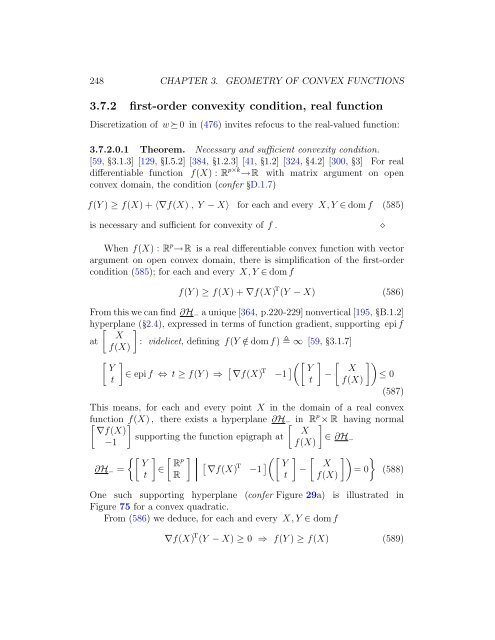Chapter 3 Geometry of convex functions - Meboo Publishing ...
Chapter 3 Geometry of convex functions - Meboo Publishing ...
Chapter 3 Geometry of convex functions - Meboo Publishing ...
Create successful ePaper yourself
Turn your PDF publications into a flip-book with our unique Google optimized e-Paper software.
248 CHAPTER 3. GEOMETRY OF CONVEX FUNCTIONS<br />
3.7.2 first-order <strong>convex</strong>ity condition, real function<br />
Discretization <strong>of</strong> w ≽0 in (476) invites refocus to the real-valued function:<br />
3.7.2.0.1 Theorem. Necessary and sufficient <strong>convex</strong>ity condition.<br />
[59,3.1.3] [129,I.5.2] [384,1.2.3] [41,1.2] [324,4.2] [300,3] For real<br />
differentiable function f(X) : R p×k →R with matrix argument on open<br />
<strong>convex</strong> domain, the condition (conferD.1.7)<br />
f(Y ) ≥ f(X) + 〈∇f(X) , Y − X〉 for each and every X,Y ∈ domf (585)<br />
is necessary and sufficient for <strong>convex</strong>ity <strong>of</strong> f .<br />
⋄<br />
When f(X) : R p →R is a real differentiable <strong>convex</strong> function with vector<br />
argument on open <strong>convex</strong> domain, there is simplification <strong>of</strong> the first-order<br />
condition (585); for each and every X,Y ∈ domf<br />
f(Y ) ≥ f(X) + ∇f(X) T (Y − X) (586)<br />
From this we can find ∂H − a unique [364, p.220-229] nonvertical [195,B.1.2]<br />
hyperplane [ ](2.4), expressed in terms <strong>of</strong> function gradient, supporting epif<br />
X<br />
at : videlicet, defining f(Y /∈ domf) ∞ [59,3.1.7]<br />
f(X)<br />
[ ] Y<br />
∈ epif ⇔ t ≥ f(Y ) ⇒ [ ∇f(X) T −1 ]([ ] [ ])<br />
Y X<br />
− ≤ 0<br />
t<br />
t f(X)<br />
(587)<br />
This means, for each and every point X in the domain <strong>of</strong> a real <strong>convex</strong><br />
[ function ] f(X) , there exists a hyperplane ∂H − [ in R p ] × R having normal<br />
∇f(X)<br />
X<br />
supporting the function epigraph at ∈ ∂H<br />
−1<br />
f(X)<br />
−<br />
{[ ] [ ] Y R<br />
p [<br />
∂H − = ∈ ∇f(X) T −1 ]([ ] [ ]) }<br />
Y X<br />
− = 0 (588)<br />
t R<br />
t f(X)<br />
One such supporting hyperplane (confer Figure 29a) is illustrated in<br />
Figure 75 for a <strong>convex</strong> quadratic.<br />
From (586) we deduce, for each and every X,Y ∈ domf<br />
∇f(X) T (Y − X) ≥ 0 ⇒ f(Y ) ≥ f(X) (589)
















